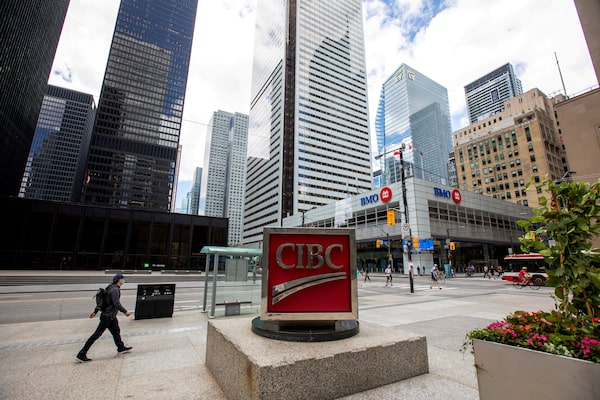
Investors are expected to look past profits for signs that businesses and consumers are starting to borrow again – an important barometer to show that the economy is recovering.Carlos Osorio/Reuters
Canada’s big banks are starting to see demand for loans return as they prepare to report earnings, but the highly contagious Delta variant has created a new wave of uncertainty about whether the economic rebound can keep its momentum.
The six largest banks will release financial results for the fiscal third quarter this week, and most analysts expect earnings per share to be about 3 per cent to 5 per cent lower than the previous quarter, but more than 40 per cent better than in the same quarter a year ago.
Investors are expected to look past profits for signs that businesses and consumers are starting to borrow again – an important barometer to show that the economy is recovering. Balances in loan portfolios have increased at a sluggish pace so far this year, and early signs of a pick-up in lending could be jeopardized by a fourth wave of COVID-19 cases.
“Not surprisingly the key topic of interest this quarter will be the pace of the economic recovery and the ability of the Delta variant to derail it,” said Meny Grauman, an analyst at Scotia Capital Inc., in a note to clients.
On Tuesday, Bank of Nova Scotia and Bank of Montreal will be first to report financial results for the three months that ended July 31. Royal Bank of Canada and National Bank of Canada release results on Wednesday, followed by Toronto-Dominion Bank and Canadian Imperial Bank of Commerce on Thursday.
Loan books are expected to grow modestly, with balances rising 1 per cent from the previous quarter and 1.1 per cent year over year, according to Darko Mihelic, an analyst at RBC Dominion Securities Inc. Once again, mortgage loans should stand out as the driving force behind much of that increase – total mortgages rose 10.5 per cent on average in June, compared with the same month last year.
The latest monthly regulatory data show a “slight uptick in loan growth,” Mr. Mihelic said in a research note. On average, the month-over-month increase in unsecured personal loan balances, which include credit cards, increased from 0.6 per cent in May to 1 per cent in June. But the pandemic has created a glut of savings that consumers and companies have yet to spend.
“Individuals and businesses are sitting on excess cash … which has resulted in a material overhang for loan growth,” said Paul Holden, an analyst at CIBC World Markets Inc., in a note to clients.
Once again, large banks are expected to recover a combined $1-billion or more from reserves set aside early in the pandemic to cover potential loan losses that mostly haven’t materialized. That should boost profits, but bankers may remain cautious about how much they release, faced with concerns about the Delta variant.
“I think the sentiment around the executive suites of the major banks is, we all hope we’re past the peak of the pandemic, but nobody I’m speaking to believes we’re out of the woods yet,” said Geoff Rush, senior partner in the financial services practice at KPMG Canada, in an interview. “I would expect to see some further release of provisions, just not in the same quantum that we saw in [the fiscal second quarter].”
The pandemic isn’t the only challenge banks face this quarter. Another key source of profits through the pandemic – revenue from trading and advisory work in capital markets – is also expected to ease after a string of strong quarters.
“We expect to see sequential weakness in the segment on lower trading revenue with volatility and volumes having fallen meaningfully during the quarter,” said Mike Rizvanovic, an analyst at Credit Suisse, in a research note. “However, continued strength in deal activity should help mitigate part of that impact through elevated [mergers and acquisitions and] advisory fees.”
There are also some hopeful signs on the horizon. As of mid-July, consumer spending had bounced back as lockdown restrictions eased in Canada and the United States, rising 13 per cent above prepandemic levels two years earlier, according to RBC Economics. Spending on hospitality and entertainment showed the strongest improvements, which should boost card fees charged by banks.
“I think so much about how well banks do is going to turn on consumer sentiment or consumer behaviour,” Mr. Rush of KPMG said.
Banks are also sitting on an estimated $37-billion of excess capital, according to National Bank Financial Inc. analyst Gabriel Dechaine. That gives them a rare opportunity to make significant investments in their businesses or acquisitions to expand their reach.
Analysts expect that restrictions on dividend increases and share buybacks imposed by regulators early in the pandemic could be lifted later this year. Once they are removed, banks could hike dividends by 6 per cent to 8 per cent and buy back up to 2 per cent of shares on average, according to CIBC’s Mr. Holden.
Your time is valuable. Have the Top Business Headlines newsletter conveniently delivered to your inbox in the morning or evening. Sign up today.
 James Bradshaw
James Bradshaw